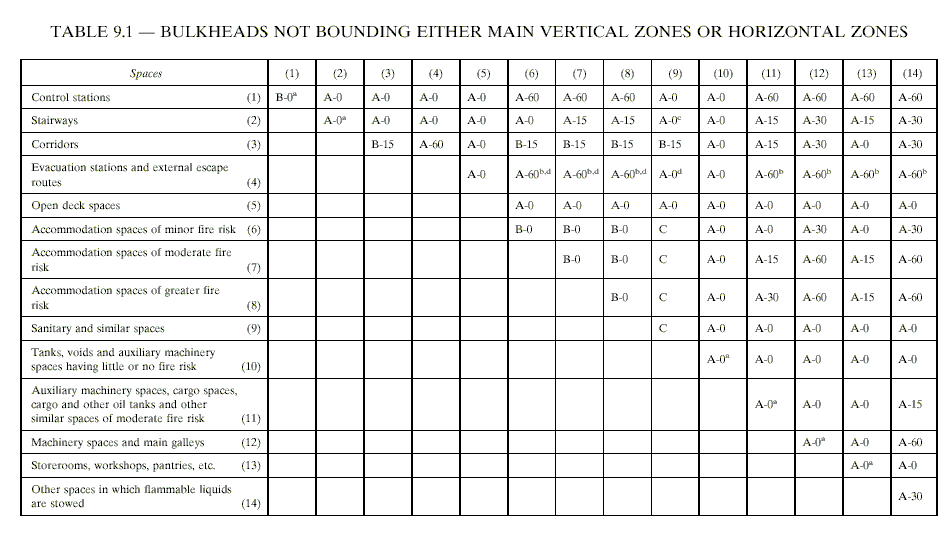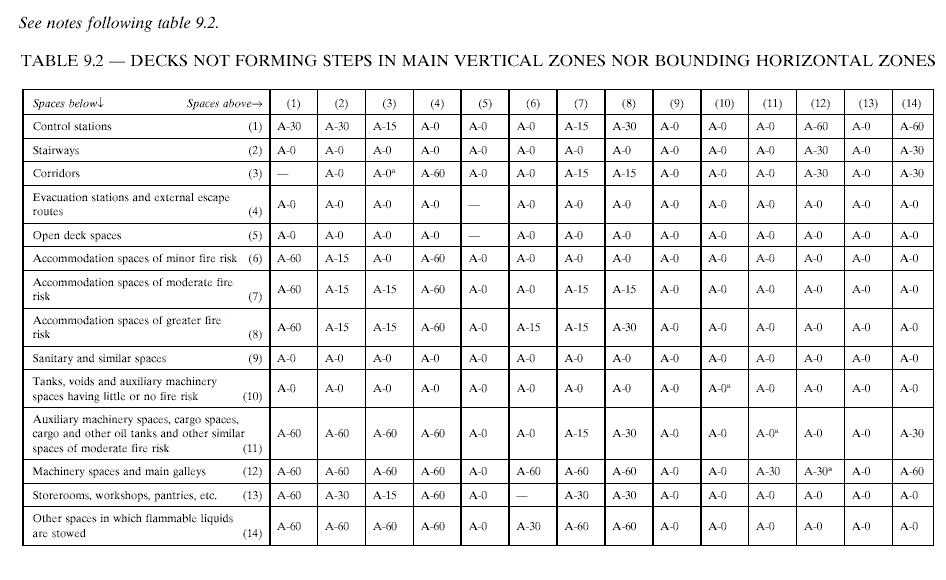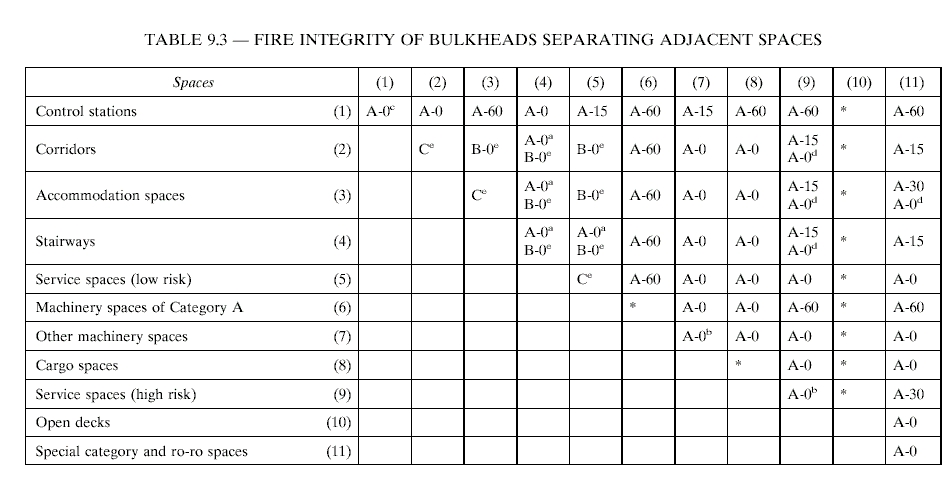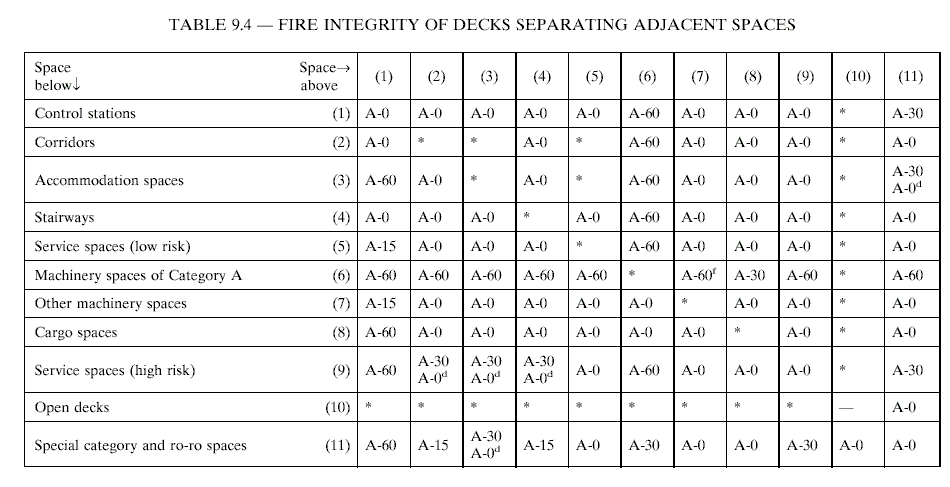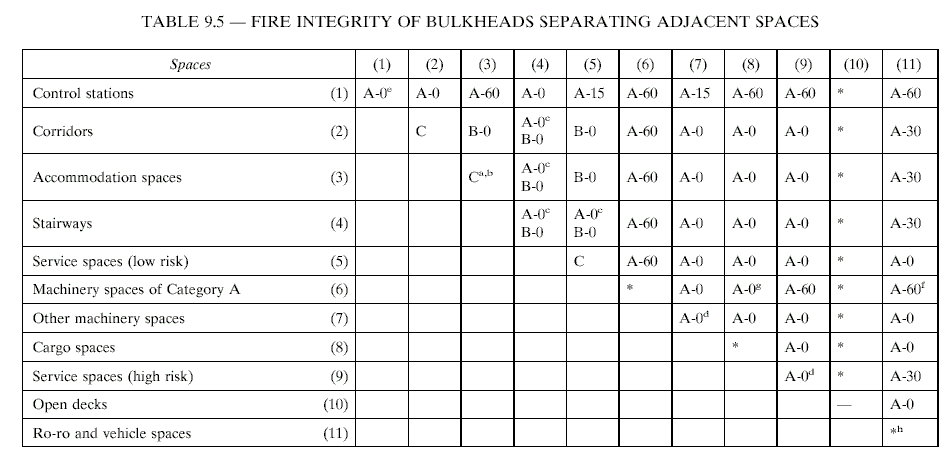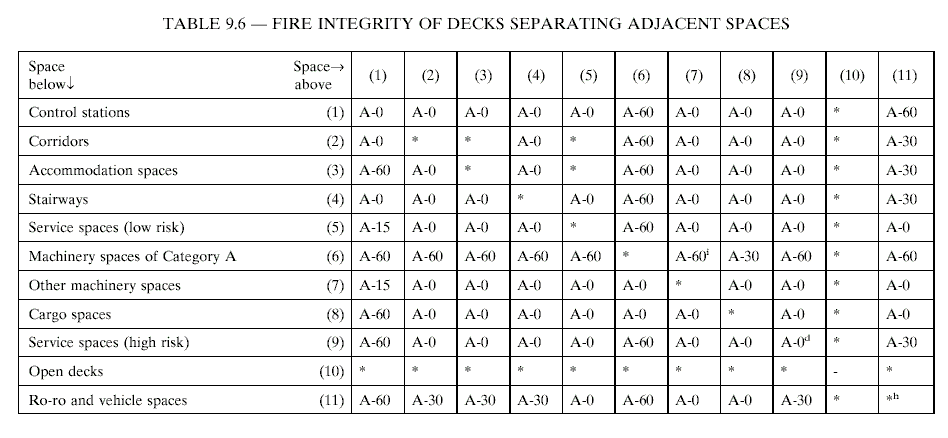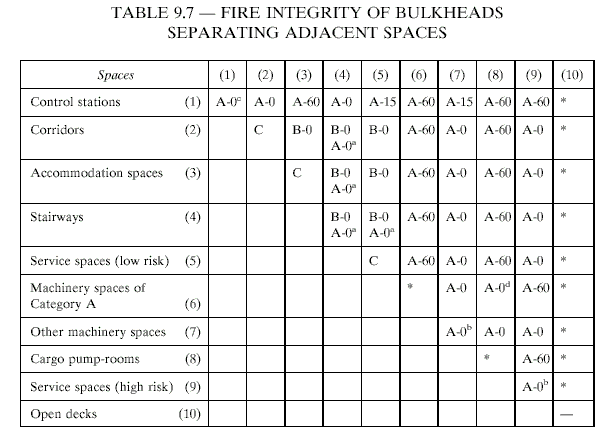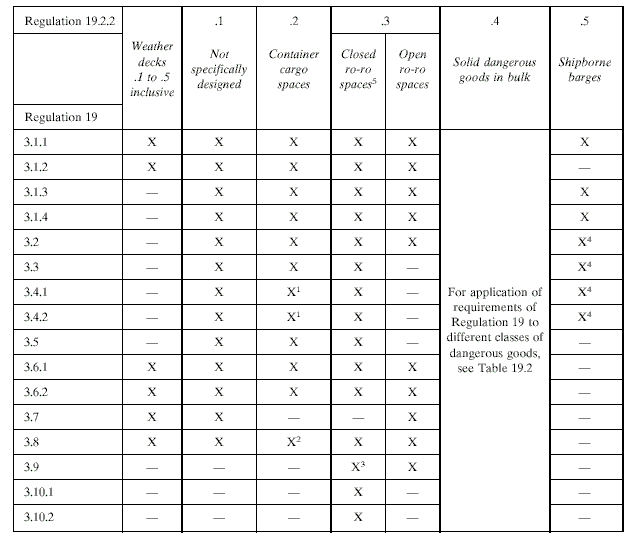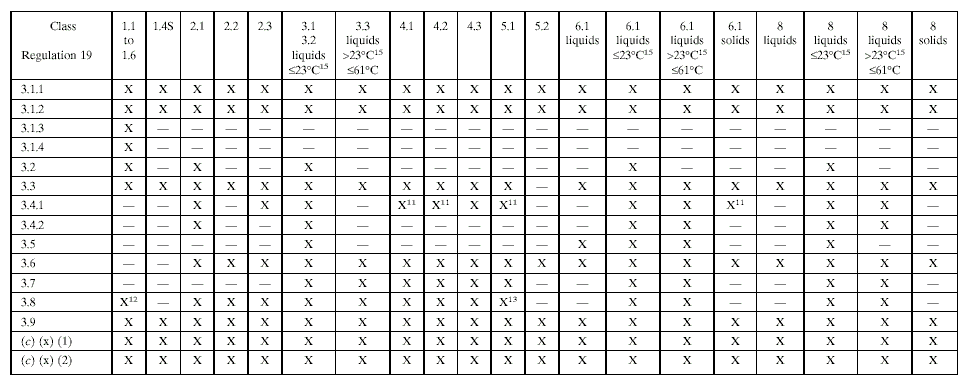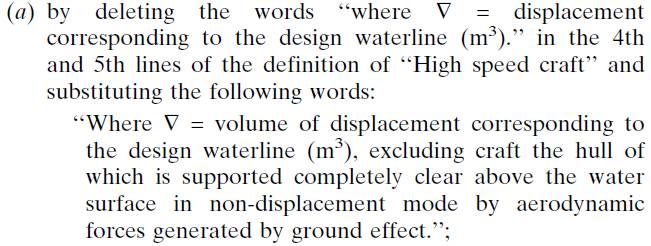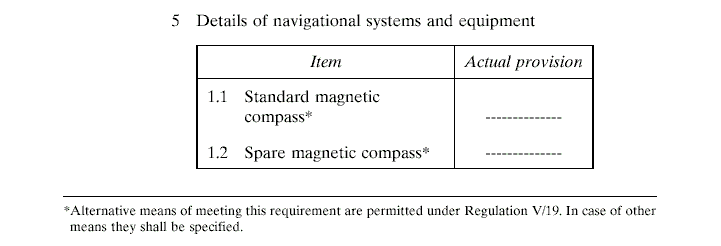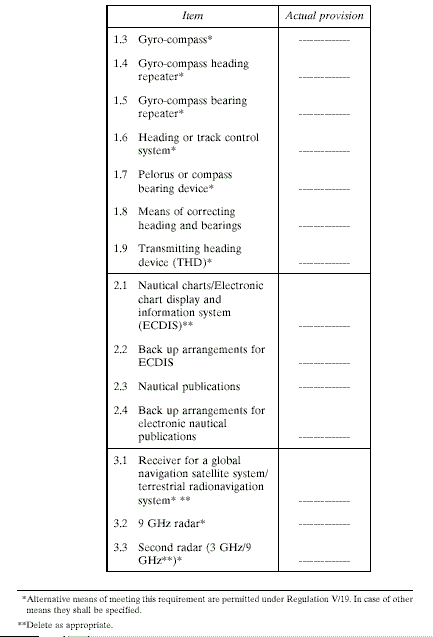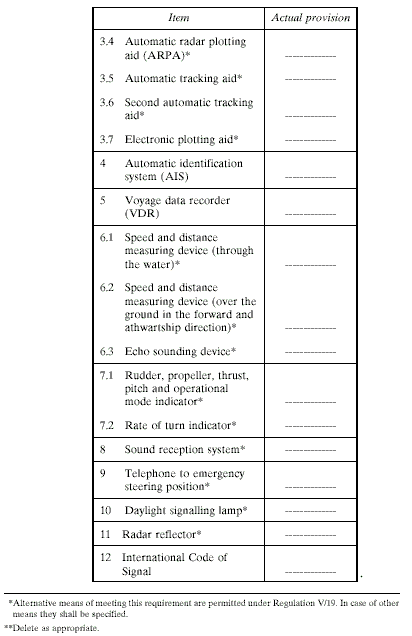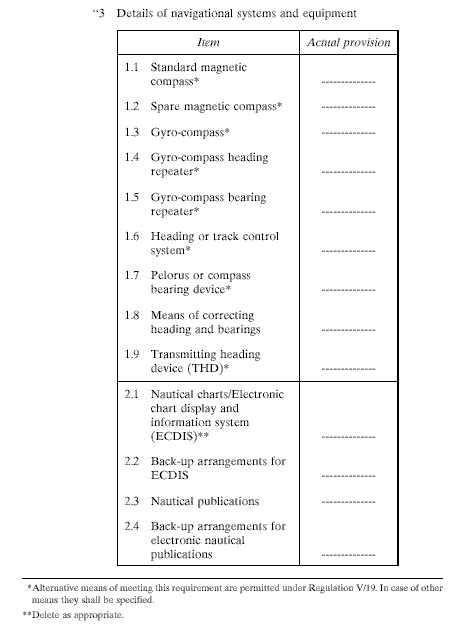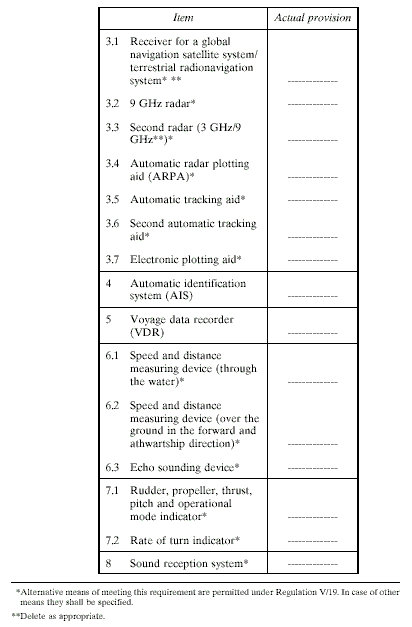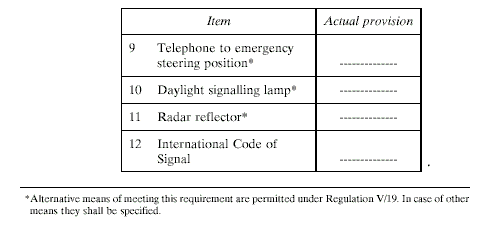6. Chapter II-2 of the principal Regulations is deleted and the following Chapter substituted therefor:“ | CONSTRUCTION — FIRE PROTECTION,
FIRE DETECTION AND FIRE EXTINCTION |
| | | |
|
| (a) | | (i) | Unless expressly provided otherwise, this Chapter shall apply to ships constructed on or after 1st July 2002. | | (ii) | For the purpose of this Chapter:| (1) | the expression “ships constructed” means ships the keels of which are laid or which are at a similar stage of construction; | | (2) | the expression “all ships” means ships, irrespective of type, constructed before, on or after 1st July 2002; and | | (3) | a cargo ship, whenever built, which is converted to a passenger ship shall be treated as a passenger ship constructed on the date on which such a conversion commences. |
| | (iii) | For the purpose of this Chapter, the expression a “similar stage of construction” means the stage at which:| (1) | construction identifiable with a specific ship begins; and | | (2) | assembly of that ship has commenced comprising at least 50 tonnes or one per cent of the estimated mass of all structural material, whichever is less. |
|
| | Applicable requirements to existing ships | | (b) | | (i) | Unless expressly provided otherwise, ships constructed before 1st July 2002 shall comply with the requirements which are applicable under this Chapter in force immediately before that date. | | (ii) | Ships constructed before 1st July 2002 shall also comply with:| (1) | paragraphs (c), (f)(v) and (f)(vii) as appropriate; | | (2) | paragraphs (c)(iv) (2) to (5) and (d)(iii) of Regulation 13 and Part E, except paragraphs (c)(ii) (2) and (3) of Regulation 16 thereof, as appropriate, not later than the date of the first survey after 1st July 2002; | | (3) | paragraphs (d)(i) (3) and (f)(iv) of Regulation 10 for new installations only; and | | (4) | paragraphs (e)(vi) of Regulation 10 not later than 1st October 2005 for passenger ships of 2,000 tons and above. |
|
| | Repairs, alterations, modifications and outfitting | | (c) | | (i) | All ships which undergo repairs, alterations, modifications and outfitting related thereto shall continue to comply with at least the requirements previously applicable to these ships. Such ships, if constructed before 1st July 2002, shall, as a rule, comply with the requirements for ships constructed on or after that date to at least the same extent as they did before undergoing such repairs, alterations, modifications or outfitting. | | (ii) | Repairs, alterations and modifications which substantially alter the dimensions of a ship or the passenger accommodation spaces, or substantially increase a ship’s service life and outfitting related thereto shall meet the requirements for ships constructed on or after 1st July 2002 in so far as the Director deems reasonable and practicable. |
| | Exemptions | | (d) | | (i) | The Director may, if he considers that the sheltered nature and conditions of the voyage are such as to render the application of any specific requirements of this Chapter unreasonable or unnecessary, exempt2 from those requirements individual ships or classes of ships entitled to fly the flag of its State, provided that such ships, which, in the course of their voyage, do not sail at distances of more than 20 miles from the nearest land.| 2 Refer to port State concurrence with SOLAS exemptions (MSC/Circ.606). |
| | (ii) | In the case of passenger ships which are employed in special trades for the carriage of large numbers of special trade passengers, such as the pilgrim trade, the Director, if satisfied that it is impracticable to enforce compliance with the requirements of this Chapter, may exempt such ships from those requirements, provided that they comply fully with the provisions of:| (1) | the rules annexed to the Special Trade Passenger Ships Agreement, 1971; and | | (2) | the rules annexed to the Protocol on Space Requirements for Special Trade Passenger Ships, 1973. |
|
| | Applicable requirements depending on ship type | | (e) | Unless expressly provided otherwise:| (i) | requirements not referring to a specific ship type shall apply to ships of all types; and | | (ii) | requirements referring to “tankers” shall apply to tankers subject to the requirements specified in paragraph (f) below. |
| | Application of requirements for tankers | | (f) | | (i) | Requirements for tankers in this Chapter shall apply to tankers carrying crude oil or petroleum products having a flashpoint not exceeding 60ºC (closed cup test), as determined by an approved flashpoint apparatus, and a Reid vapour pressure which is below the atmospheric pressure or other liquid products having a similar fire hazard. | | (ii) | Where liquid cargoes other than those referred to in paragraph (f)(i) or liquefied gases which introduce additional fire hazards are intended to be carried, additional safety measures shall be required, having due regard to the provisions of the International Bulk Chemical Code, as defined in Regulation 8(a) of Chapter VII, the Bulk Chemical Code, the International Gas Carrier Code, as defined in Regulation 11(a) of Chapter VII, and the Gas Carrier Code, as appropriate.| (1) | A liquid cargo with a flashpoint of less than 60ºC for which a regular foam fire-fighting system complying with the Fire Safety Systems Code is not effective, is considered to be a cargo introducing additional fire hazards in this context. The following additional measures are required:| (A) | the foam shall be of alcohol resistant type; | | (B) | the type of foam concentrates for use in chemical tankers shall be to the satisfaction of the Director taking into account the guidelines developed by the Organization;3 and| 3 Refer to the Guidelines for performance and testing criteria and surveys of expansion foam concentrates for fire-extinguishing systems for chemical tankers (MSC/Circ.799). |
| | (C) | the capacity and application rates of the foam extinguishing system shall comply with Chapter 11 of the International Bulk Chemical Code, except that lower application rates may be accepted based on performance tests. For tankers fitted with inert gas systems, a quantity of foam concentrate sufficient for 20 min of foam generation may be accepted.4| 4 Refer to the Information on flashpoint and recommended fire-fighting media for chemicals to which neither the IBC nor BCH Codes apply (MSC/Circ.553). |
|
| | (2) | For the purpose of this Regulation, a liquid cargo with a vapour pressure greater than 1.013 bar absolute at 37.8°C is considered to be a cargo introducing additional fire hazards. Ships carrying such substances shall comply with paragraph 15.14 of the International Bulk Chemical Code. When ships operate in restricted areas and at restricted times, the Director concerned may agree to waive the requirements for refrigeration systems in accordance with paragraph 15.14.3 of the International Bulk Chemical Code. |
| | (iii) | Liquid cargoes with a flashpoint exceeding 60ºC other than oil products or liquid cargoes subject to the requirements of the International Bulk Chemical Code are considered to constitute a low fire risk, not requiring the protection of a fixed foam extinguishing system. | | (iv) | Tankers carrying petroleum products with a flashpoint exceeding 60ºC (closed cup test), as determined by an approved flashpoint apparatus, shall comply with the requirements provided in paragraphs (b)(i) (4) (D) and (j)(ii) (3) of Regulation 10 and the requirements for cargo ships other than tankers, except that, in lieu of the fixed fire-extinguishing system required in paragraph (g) of Regulation 10, they shall be fitted with a fixed deck foam system which shall comply with the provisions of the Fire Safety Systems Code. | | (v) | Combination carriers constructed before, on or after 1st July 2002 shall not carry cargoes other than oil unless all cargo spaces are empty of oil and gas-freed or unless the arrangements provided in each case have been approved by the Director taking into account the guidelines developed by the Organization.5| 5 Refer to the Guidelines for inert gas systems (MSC/Circ.353), as amended by MSC/Circ.387. |
| | (vi) | Chemical tankers and gas carriers shall comply with the requirements for tankers, except where alternative and supplementary arrangements are provided to the satisfaction of the Director, having due regard to the provisions of the International Bulk Chemical Code and the International Gas Carrier Code, as appropriate. | | (vii) | The requirements of paragraphs (e)(x) (1) (A) and (D) of Regulations 4, and a system for continuous monitoring of the concentration of hydrocarbon gases shall be fitted on all tankers constructed before 1st July 2002 by the date of the first scheduled dry-docking after 1st July 2002, but not later than 1st July 2005. Sampling points or detector heads shall be located in suitable positions in order that potentially dangerous leakages are readily detected. When the hydrocarbon gas concentration reaches a pre-set level which shall not be higher than 10% of the lower flammable limit, a continuous audible and visual alarm signal shall be automatically effected in the pump-room and cargo control room to alert personnel to the potential hazard. However, exising monitoring systems already fitted having a pre-set level not greater than 30% of the lower flammable limit may be accepted. | | Fire safety objectives and functional requirements |
|
|
|
| | Fire safety objectives | | (a) | | (i) | The fire safety objectives of this Chapter are to:| (1) | prevent the occurrence of fire and explosion; | | (2) | reduce the risk to life caused by fire; | | (3) | reduce the risk of damage caused by fire to the ship, its cargo and the environment; | | (4) | contain, control and suppress fire and explosion in the compartment of origin; and | | (5) | provide adequate and readily accessible means of escape for passengers and crew. |
|
| | Functional requirements | | (b) | | (i) | In order to achieve the fire safety objectives set out in paragraph (a) above, the following functional requirements are embodied in the Regulations of this Chapter as appropriate:| (1) | division of the ship into main vertical and horizontal zones by thermal and structural boundaries; | | (2) | separation of accommodation spaces from the remainder of the ship by thermal and structural boundaries; | | (3) | restricted use of combustible materials; | | (4) | detection of any fire in the zone of origin; | | (5) | containment and extinction of any fire in the space of origin; | | (6) | protection of means of escape and access for fire-fighting; | | (7) | ready availability of fire-extinguishing appliances; and | | (8) | minimization of possibility of ignition of flammable cargo vapour. |
|
| | Achievement of the fire safety objectives | | (c) | The fire safety objectives set out in paragraph (a) above shall be achieved by ensuring compliance with the prescriptive requirements specified in Parts B, C, D, E or G, or by alternative design and arrangements which comply with Part F. A ship shall be considered to meet the functional requirements set out in paragraph (b) and to achieve the fire safety objectives set out in paragraph (a) when either:| (i) | the ship’s designs and arrangements, as a whole, complies with the relevant prescriptive requirements in Parts B, C, D, E or G; | | (ii) | the ship’s designs and arrangements, as a whole, have been reviewed and approved in accordance with Part F; or | | (iii) | Part(s) of the ship’s designs and arrangements have been reviewed and approved in accordance with Part F and the remaining parts of the ship comply with the relevant prescriptive requirements in Parts B, C, D, E or G. |
|
For the purpose of this Chapter, unless expressly provided otherwise, the following definitions shall apply: | (a) | “Accommodation spaces” are those spaces used for public spaces, corridors, lavatories, cabins, offices, hospitals, cinemas, game and hobby rooms, barber shops, pantries containing no cooking appliances and similar spaces; | | (b) | ““A” class divisions” are those divisions formed by bulkheads and decks which comply with the following criteria:| (i) | they are constructed of steel or other equivalent material; | | (ii) | they are suitably stiffened; | | (iii) | they are insulated with approved non-combustible materials such that the average temperature of the unexposed side will not rise more than 140ºC above the original temperature, nor will the temperature, at any one point, including any joint, rise more than 180ºC above the original temperature, within the time listed below: | | (iv) | they are constructed as to be capable of preventing the passage of smoke and flame to the end of the one-hour standard fire test; and | | (v) | the Director has required a test of a prototype bulkhead or deck in accordance with the Fire Test Procedures Code to ensure that it meets the above requirements for integrity and temperature rise. |
| | (c) | “Atriums” are public spaces within a single main vertical zone spanning three or more open decks. | | (d) | ““B” class divisions” are those divisions formed by bulkheads, decks, ceilings or linings which comply with the following criteria:| (i) | they are constructed of approved non-combustible materials and all materials used in the construction and erection of “B” class divisions are non-combustible, with the exception that combustible veneers may be permitted provided they meet other appropriate requirements of this Chapter; | | (ii) | they have an insulation value such that the average temperature of the unexposed side will not rise more than 140ºC above the original temperature, nor will the temperature at any one point, including any joint, rise more than 225ºC above the original temperature, within the time listed below: | | (iii) | they are constructed as to be capable of preventing the passage of flame to the end of the first half hour of the standard fire test; and | | (iv) | the Director has required a test of a prototype division in accordance with the Fire Test Procedures Code to ensure that it meets the above requirements for integrity and temperature rise. |
| | (e) | “Bulkhead deck” is the uppermost deck up to which the transverse watertight bulkheads are carried. | | (f) | “Cargo area” is that part of the ship that contains cargo holds, cargo tanks, slop tanks and cargo pump-rooms including pump-rooms, cofferdams, ballast and void spaces adjacent to cargo tanks and also deck areas throughout the entire length and breadth of the part of the ship over the abovementioned spaces. | | (g) | “Cargo ship” is a ship as defined in Regulation 2 of Chapter I. | | (h) | “Cargo spaces” are spaces used for cargo, cargo oil tanks, tanks for other liquid cargo and trunks to such spaces. | | (i) | “Central control station” is a control station in which the following control and indicator functions are centralized:| (i) | fixed fire detection and fire alarm systems; | | (ii) | automatic sprinkler, fire detection and fire alarm systems; | | (iii) | fire door indicator panels; | | (iv) | fire door closure; | | (v) | watertight door indicator panels; | | (vi) | watertight door closures; | | (vii) | ventilation fans; | | (viii) | general/fire alarms; | | (ix) | communication systems including telephones; and | | (x) | microphones to public address systems. |
| | (j) | ““C” class divisions” are divisions constructed of approved non-combustible materials. They need meet neither requirements relative to the passage of smoke and flame nor limitations relative to the temperature rise. Combustible veneers are permitted provided they meet the requirements of this Chapter. | | (k) | “Chemical tanker” is a cargo ship constructed or adapted and used for the carriage in bulk of any liquid product of a flammable nature listed in Chapter 17 of the International Bulk Chemical Code, as defined in Regulation 8(a) of Chapter VII. | | (l) | “Closed ro-ro spaces” are ro-ro spaces which are neither open ro-ro spaces nor weather decks. | | (m) | “Closed vehicle spaces” are vehicle spaces which are neither open vehicle spaces nor weather decks. | | (n) | “Combination carrier” is a cargoes ship designed to carry both oil and solid cargoes in bulk. | | (o) | “Combustible material” is any material other than a non-combustible material. | | (p) | “Continuous “B””class ceilings or linings are those “B” class ceilings or linings which terminate at an “A” or “B” class division. | | (q) | “Continuously manned central control station” is a central control station which is continuously manned by a responsible member of the crew. | | (r) | “Control stations” are those spaces in which the ship’s radio or main navigating equipment or the emergency source of power is located or where the fire recording or fire control equipment is centralized. Spaces where the fire recording or fire control equipment is centralized are also considered to be a fire control station. | | (s) | “Crude oil” is any oil occurring naturally in the earth whether or not treated to render it suitable for transportation and includes crude oil where certain distillate fractions may have been removed from or added to. | | (t) | “Dangerous goods” are those goods referred to in Regulations 2 of Chapter VII. | | (u) | “Deadweight” is the difference in tonnes between the displacement of a ship in water of a specific gravity of 1.025 at the load waterline corresponding to the assigned summer freeboard and the lightweight of the ship. | | (v) | “Fire Safety Systems Code” means the International Code for the Fire Safety Systems as adopted by the Maritime Safety Committee of the Organization by resolution MSC.98 (73), as may be amended by the Organization, provided that such amendments are adopted, brought into force and take effect in accordance with the provisions of article VIII of the present Convention concerning the amendment procedures applicable to the annex other than Chapter I thereof. | | (w) | “Fire Test Procedures Code” means the International Code for Application of Fire Test Procedures as adopted by the Maritime Safety Committee of the Organization by resolution MSC.61 (67), as may be amended by the Organization, provided that such amendments are adopted, brought into force and take effect in accordance with the provisions of article VIII of the present Convention concerning the amendment procedures applicable to the annex other than Chapter I thereof. | | (x) | “Flashpoint” is the temperature in degrees Celsius (closed cup test) at which a product will give off enough flammable vapour to be ignited, as determined by an approved flashpoint apparatus. | | (y) | “Gas carrier” is a cargo ship constructed or adapted and used for the carriage in bulk of any liquefied gas or other products of a flammable nature listed in Chapter 19 of the International Gas Carrier Code, as defined in Regulation (a) of Chapter VII. | | (z) | “Helideck” is a purpose-built helicopter landing area located on a ship including all structure, fire-fighting appliances and other equipment necessary for the safe operation of helicopters. | | (aa) | “Helicopter facility” is a helideck including any refuelling and hangar facilities. | | (bb) | “Lightweight” is the displacement of a ship in tonnes without cargo, fuel, lubricating oil, ballast water, fresh water and feedwater in tanks, consumable stores, and passengers and crew and their effects. | | (cc) | “Low flame-spread” means that the surface thus described will adequately restrict the spread of flame, this being determined in accordance with the Fire Test Procedures Code. | | (dd) | “Machinery spaces” are machinery spaces of category A and other spaces containing propulsion machinery, boilers, oil fuel units, steam and internal combustion engines, generators and major electrical machinery, oil filling stations, refrigerating, stabilizing, ventilation and air conditioning machinery, and similar spaces, and trunks to such spaces. | | (ee) | “Machinery spaces” of category A are those spaces and trunks to such spaces which contain either:| (i) | internal combustion machinery used for main propulsion; | | (ii) | internal combustion machinery used for purposes other than main propulsion where such machinery has in the aggregate a total power output of not less than 375 kW; or | | (iii) | any oil-fired boiler or oil fuel unit, or any oil-fired equipment other than boilers, such as inert gas generators, incinerators, etc. |
| | (ff) | “Main vertical zones” are those sections into which the hull, superstructure and deckhouses are divided by “A” class divisions, the mean length and width of which on any deck does not in general exceed 40 m. | | (gg) | “Non-combustible material” is a material which neither burns nor gives off flammable vapours in sufficient quantity for self-ignition when heated to approximately 750°C, this being determined in accordance with the Fire Test Procedures Code. | | (hh) | “Oil fuel unit” is the equipment used for the preparation of oil fuel for delivery to an oil-fired boiler, or equipment used for the preparation for delivery of heated oil to an internal combustion engine, and includes any oil pressure pumps, filters and heaters dealing with oil at a pressure of more than 0.18 N/mm2. | | (ii) | “Open ro-ro spaces” are those ro-ro spaces that are either open at both ends or have an opening at one end, and are provided with adequate natural ventilation effective over their entire length through permanent openings distributed in the side plating or deckhead or from above, having a total area of at least 10% of the total area of the space sides. | | (jj) | “Open vehicle spaces” are those vehicle spaces either open at both ends, or have an opening at one end and are provided with adequate natural ventilation effective over their entire length through permanent openings distributed in the side plating or deckhead or from above, having a total area of at least 10% of the total area of the space sides. | | (kk) | “Passenger ship” is a ship as defined in Regulations 2 of Chapter I. | | (ll) | “Prescriptive requirements” means the construction characteristics, limiting dimensions, or fire safety systems specified in Part B, C, D, E or G. | | (mm) | “Public spaces” are those portions of the accommodation which are used for halls, dining rooms, lounges and similar permanently enclosed spaces. | | (nn) | “Rooms containing furniture and furnishings of restricted fire risk”, for the purpose of Regulation 9, are those rooms containing furniture and furnishings of restricted fire risk (whether cabins, public spaces, offices or other types of accommodation) in which:| (i) | case furniture such as desks, wardrobes, dressing tables, bureaux, dressers, are constructed entirely of approved non-combustible materials, except that a combustible veneer not exceeding 2 mm may be used on the working surface of such articles; | | (ii) | free-standing furniture such as chairs, sofas, tables, are constructed with frames of non-combustible materials; | | (iii) | draperies, curtains and other suspended textile materials have qualities of resistance to the propagation of flame not inferior to those of wool having a mass of 0.8 kg/m2, this being determined in accordance with the Fire Test Procedures Code; | | (iv) | floor coverings have low flame-spread characteristics; | | (v) | exposed surfaces of bulkheads, linings and ceilings have low flame-spread characteristics; | | (vi) | upholstered furniture has qualities of resistance to the ignition and propagation of flame, this being determined in accordance with the Fire Test Procedures Code; and | | (vii) | bedding components have qualities of resistance to the ignition and propagation of flame, this being determined in accordance with the Fire Test Procedures Code. |
| | (oo) | “Ro-ro spaces” are spaces not normally subdivided in any way and normally extending to either a substantial length or the entire length of the ship in which motor vehicles with fuel in their tanks for their own propulsion and/or goods (packaged or in bulk, in or on rail or road cars, vehicles (including road or rail tankers), trailers, containers, pallets, demountable tanks or in or on similar stowage units or other receptacles) can be loaded and unloaded normally in a horizontal direction. | | (pp) | “Ro-ro passenger ship” means a passenger ship with ro-ro spaces or special category spaces. | | (qq) | “Steel or other equivalent material” means any non-combustible material which, by itself or due to insulation provided, has structural and integrity properties equivalent to steel at the end of the applicable exposure to the standard fire test (e.g. aluminium alloy with appropriate insulation). | | (rr) | “Sauna” is a hot room with temperatures normally varying between 80°—120°C where the heat is provided by a hot surface (e.g. by an electrically-heated oven). The hot room may also include the space where the oven is located and adjacent bathrooms. | | (ss) | “Service spaces” are those spaces used for galleys, pantries containing cooking appliances, lockers, mail and specie rooms, storerooms, workshops other than those forming part of the machinery spaces, and similar spaces and trunks to such spaces. | | (tt) | “Special category spaces” are those enclosed vehicle spaces above and below the bulkhead deck, into and from which vehicles can be driven and to which passengers have access. Special category spaces may be accommodated on more than one deck provided that the total overall clear height for vehicles does not exceed 10 m. | | (uu) | “A standard fire test” is a test in which specimens of the relevant bulkheads or decks are exposed in a test furnace to temperatures corresponding approximately to the standard time-temperature curve in accordance with the test method specified in the Fire Test Procedures Code. | | (vv) | “Tanker” is a ship as defined in Regulation 2 of Chapter I. | | (ww) | “Vehicle spaces” are cargo spaces intended for carriage of motor vehicles with fuel in their tanks for their own propulsion. | | (xx) | “Weather deck” is a deck which is completely exposed to the weather from above and from at least two sides. |
| Part B — Prevention of Fire and Explosion |
|
| (a) | The purpose of this Regulation is to prevent the ignition of combustible materials or flammable liquids. For this purpose, the following functional requirements shall be met:| (i) | means shall be provided to control leaks of flammable liquids; | | (ii) | means shall be provided to limit the accumulation of flammable vapours; | | (iii) | the ignitability of combustible materials shall be restricted; | | (iv) | ignition sources shall be restricted; | | (v) | ignition sources shall be separated from combustible materials and flammable liquids; and | | (vi) | the atmosphere in cargo tanks shall be maintained out of the explosive range. |
| | Arrangements for oil fuel, lubrication oil and other flammable oils | | (b) | | Limitations in the use of oils as fuel |
| The following limitations shall apply to the use of oil as fuel:| (1) | except as otherwise permitted by this paragraph, no oil fuel with a flashpoint of less than 60ºC shall be used;6| 6 Refer to the Recommended procedures to prevent the illegal or accidental use of low flashpoint cargo oil as fuel adopted by the Organization by resolution A.565(14). |
| | (2) | in emergency generators oil fuel with a flashpoint of not less than 43ºC may be used; | | (3) | the use of oil fuel having a flashpoint of less than 60ºC but not less than 43ºC may be permitted (e.g., for feeding the emergency fire pump’s engines and the auxiliary machines which are not located in the machinery spaces of category A) subject to the following:| (A) | fuel oil tanks except those arranged in double bottom compartments shall be located outside of machinery spaces of category A; | | (B) | provisions for the measurement of oil temperature are provided on the suction pipe of the oil fuel pump; | | (C) | stop valves and/or cocks are provided on the inlet side and outlet side of the oil fuel strainers; and | | (D) | pipe joints of welded construction or of circular cone type or spherical type union joint are applied as much as possible; and |
| | (4) | in cargo ships the use of fuel having a lower flashpoint than otherwise specified in paragraph (b)(i), for example crude oil, may be permitted provided that such fuel is not stored in any machinery space and subject to the approval by the Director of the complete installation. |
| | (ii) | Arrangements for oil fuel | In a ship in which oil fuel is used, the arrangements for the storage, distribution and utilization of the oil fuel shall be such as to ensure the safety of the ship and persons on board and shall at least comply with the following provisions.| (1) | Location of oil fuel systemsAs far as practicable, parts of the oil fuel system containing heated oil under pressure exceeding 0.18 N/mm2 shall not be placed in a concealed position such that defects and leakage cannot readily be observed. The machinery spaces in way of such parts of the oil fuel system shall be adequately illuminated. |
|
| | (2) | Ventilation of machinery spacesThe ventilation of machinery spaces shall be sufficient under normal conditions to prevent accumulation of oil vapour. |
|
| | (3) | Oil fuel tanks| (A) | Fuel oil, lubrication oil and other flammable oils shall not be carried in forepeak tanks. | | (B) | As far as practicable, oil fuel tanks shall be part of the ships structure and shall be located outside machinery spaces of category A. Where oil fuel tanks, other than double bottom tanks, are necessarily located adjacent to or within machinery spaces of category A, at least one of their vertical sides shall be contiguous to the machinery space boundaries, and shall preferably have a common boundary with the double bottom tanks, and the area of the tank boundary common with the machinery spaces shall be kept to a minimum. Where such tanks are situated within the boundaries of machinery spaces of category A they shall not contain oil fuel having a flashpoint of less than 60ºC. In general, the use of free-standing oil fuel tanks shall be avoided. When such tanks are employed their use shall be prohibited in category A machinery spaces on passenger ships. Where permitted, they shall be placed in an oil-tight spill tray of ample size having a suitable drain pipe leading to a suitably sized spill oil tank. | | (C) | No oil fuel tank shall be situated where spillage or leakage therefrom can constitute a fire or explosion hazard by falling on heated surfaces. | | (D) | Oil fuel pipes, which, if damaged, would allow oil to escape from a storage, settling or daily service tank having a capacity of 500 litres and above situated above the double bottom, shall be fitted with a cock or valve directly on the tank capable of being closed from a safe position outside the space concerned in the event of a fire occurring in the space in which such tanks are situated. In the special case of deep tanks situated in any shaft or pipe tunnel or similar space, valves on the tank shall be fitted, but control in the event of fire may be effected by means of an additional valve on the pipe or pipes outside the tunnel or similar space. If such an additional valve is fitted in the machinery space it shall be operated from a position outside this space. The controls for remote operation of the valve for the emergency generator fuel tank shall be in a separate location from the controls for remote operation of other valves for tanks located in machinery spaces. | | (E) | Safe and efficient means of ascertaining the amount of oil fuel contained in any oil fuel tank shall be provided. | | (I) | Where sounding pipes are used, they shall not terminate in any space where the risk of ignition of spillage from the sounding pipe might arise. In particular, they shall not terminate in passenger or crew spaces. As a general rule, they shall not terminate in machinery spaces. However, where the Director considers that these latter requirements are impracticable, it may permit termination of sounding pipes in machinery spaces on condition that all of the following requirements are met: | | (1) | an oil-level gauge is provided meeting the requirements of paragraph (b)(ii) (3) (E) (II); | | (2) | the sounding pipes terminate in locations remote from ignition hazards unless precautions are taken, such as the fitting of effective screens, to prevent the oil fuel in the case of spillage through the terminations of the sounding pipes from coming into contact with a source of ignition; and | | (3) | the termination of sounding pipes are fitted with self-closing blanking devices and with a small-diameter self-closing control cock located below the blanking device for the purpose of ascertaining before the blanking device is opened that oil fuel is not present. Provisions shall be made so as to ensure that any spillage of oil fuel through the control cock involves no ignition hazard. | | (II) | Other oil-level gauges may be used in place of sounding pipes subject to the following conditions: | | (1) | in passenger ships, such gauges shall not require penetration below the top of the tank and their failure or overfilling of the tanks shall not permit release of fuel; and | | (2) | in cargo ships, the failure of such gauges or overfilling of the tank shall not permit release of fuel into the space. The use of cylindrical gauge glasses is prohibited. The Director may permit the use of oil-level gauges with flat glasses and self-closing valves between the gauges and fuel tanks. | | (III) | The means prescribed in paragraph (b)(ii) (3) (E) (II) which are acceptable to the Director shall be maintained in the proper condition to ensure their continued accurate functioning in service. |
| | (4) | Prevention of overpressureProvisions shall be made to prevent overpressure in any oil tank or in any part of the oil fuel system, including the filling pipes served by pumps on board. Air and overflow pipes and relief valves shall discharge to a position where there is no risk of fire or explosion from the emergence of oils and vapour and shall not lead into crew spaces, passenger spaces nor into special category spaces, closed ro-ro cargo spaces, machinery spaces or similar spaces. |
|
| | (5) | Oil fuel piping| (A) | Oil fuel pipes and their valves and fittings shall be of steel or other approved material, except that restricted use of flexible pipes shall be permissible in positions where the Director is satisfied that they are necessary.7 Such flexible pipes and end attachments shall be of approved fire-resisting material of adequate strength and shall be constructed to the satisfaction of the Director. For valves, fitted to oil fuel tanks and which are under static pressure, steel or spheroidal-graphite cast iron may be accepted. However, ordinary cast iron valves may be used in piping systems where the design pressure is lower than 7 bar and the design temperature is below 60°C.| 7 Refer to recommendations published by the International Organization for Standardization, in particular, Publications ISO 15540:1999 on Test methods for fire resistance of hose assemblies and ISO 15541:1999 on Requirements for the test bench of fire resistance of hose assemblies. |
| | (B) | External high-pressure fuel delivery lines between the high-pressure fuel pumps and fuel injectors shall be protected with a jacketed piping system capable of containing fuel from a high-pressure line failure. A jacketed pipe incorporates an outer pipe into which the high-pressure fuel pipe is placed, forming a permanent assembly. The jacketed piping system shall include a means for collection of leakages and arrangements shall be provided with an alarm in case of a fuel line failure. | | (C) | Oil fuel lines shall not be locatd immediately above or near unit of high temperature including boilers, steam pipelines, exhaust manifolds, silencers or other equipment required to be insulated by paragraph (b)(ii) (6). As far as practicable, oil fuel lines shall be arranged far apart from hot surfaces, electrical installations or other sources of ignition and shall be screened or otherwise suitably protected to avoid oil spray or oil leakage onto the sources of ignition. The number of joints in such piping systems shall be kept to a minimum. | | (D) | Components of a diesel engine fuel system shall be designed considering the maximum peak pressure which will be experienced in service, including any high pressure pulses which are generated and transmitted back into the fuel supply and spill lines by the action of fuel injection pumps. Connections within the fuel supply and spill lines shall be constructed having regard to their ability to prevent pressurized oil fuel leaks while in service and after maintenance. | | (E) | In multi-engine installations which are supplied from the same fuel source, means of isolating the fuel supply and spill piping to individual engines, shall be provided. The means of isolations shall not affect the operation of the other engines and shall be operable from a position not rendered inaccessible by a fire on any of the engines. | | (F) | Where the Director may permit the conveying of oil and combustible liquids through accommodation and service spaces, the pipes conveying oil or combustible liquids shall be of a material approved by the Director having regard to the fire risk. |
| | (6) | Protection of high temperature surfaces| (A) | Surfaces with temperatures above 220°C which may be impinged as a result of a fuel system failure shall be properly insulated. | | (B) | Precautions shall be taken to prevent any oil that may escape under pressure from any pump, filter or heater from coming into contact with heated surfaces. |
|
| | (iii) | Arrangements for lubricating oil | | (1) | The arrangements for the storage, distribution and utilization of oil used in pressure lubrication systems shall be such as to ensure the safety of the ship and persons on board. The arrangements made in machinery spaces of Category A, and whenever practicable in other machinery spaces, shall at least comply with the provisions of paragraphs (b)(ii) (1), (b)(ii) (3) (C) to (E), (b)(ii) (4), (b)(ii) (5) (A), (b)(ii) (5) (C) and (b)(ii) (6), except that:| (A) | this does not preclude the use of sight-flow glasses in lubricating systems provided that they are shown by testing to have a suitable degree of fire resistance; and | | (B) | sounding pipes may be authorized in machinery spaces; however, the requirements of paragraphs (b)(ii) (3) (E) (I) (1) and (3) need not be applied on condition that the sounding pipes are fitted with appropriate means of closure. |
| | (2) | The provisions of paragraph (b)(ii) (3) (D) shall also apply to lubricating oil tanks except those having a capacity less than 500 litres, storage tanks on which valves are closed during the normal operation mode of the ship, or where it is determined that an unintended operation of a quick closing valve on the oil lubricating tank would endanger the safe operation of the main propulsion and essential auxiliary machinery. |
| | (iv) | Arrangements for other flammable oils | The arrangements for the storage, distribution and utilization of other flammable oils employed under pressure in power transmission systems, control and activating systems and heating systems shall be such as to ensure the safety of the ship and persons on board. Suitable oil collecting arrangements for leaks shall be fitted below hydraulic valves and cylinders. In locations where means of ignition are present, such arrangements shall at least comply with the provisions of paragraphs (b)(ii) (3) (C), (b)(ii) (3) (E), (b)(ii) (5) (C) and (b)(ii) (6) and with the provisions of paragraphs (b)(ii) (4) and (b)(ii) (5) (A) in respect of strength and construction. | | (v) | Arrangements for oil fuel in periodically unattended machinery spacesIn addition to the requirements of paragraphs (b)(i) to (iv), the oil fuel and lubricating oil systems in a periodically unattended machinery space shall comply with the following: |
|
|
| | (1) | where daily service oil fuel tanks are filled automatically, or by remote control, means shall be provided to prevent overflow spillages. Other equipment which treats flammable liquids automatically (e.g. oil fuel purifiers) which, whenever practicable, shall be installed in a special space reserved for purifiers and their heaters, shall have arrangements to prevent overflow spillages; and | | (2) | where daily service oil fuel tanks or settling tanks are fitted with heating arrangements, a high temperature alarm shall be provided if the flashpoint of the oil fuel can be exceeded. | | Arrangements for gaseous fuel for domestic purpose | | (c) | Gaseous fuel systems used for domestic purposes shall be approved by the Director. Storage of gas bottles shall be located on the open deck or in a well ventilated space which opens only to the open deck. | | Miscellaneous items of ignition sources and ignitability | | (d) | | (i) | Electric radiatorsElectric radiators, if used, shall be fixed in position and so constructed as to reduce fire risks to a minimum. No such radiators shall be fitted with an element so exposed that clothing, curtains, or other similar materials can be scorched or set on fire by heat from the element. |
|
| | (ii) | Waste receptaclesWaste receptacles shall be constructed of non-combustible materials with no openings in the sides or bottom. |
|
| | (iii) | Insulation surfaces protected against oil penetrationIn spaces where penetration of oil products is possible, the surface of insulation shall be impervious to oil or oil vapours. |
|
| | (iv) | Primary deck coveringsPrimary deck coverings, if applied within accommodation and service spaces and control stations, shall be of approved material which will not readily ignite, this being determined in accordance with the Fire Test Procedures Code. |
|
|
| | Cargo areas of tankers | | (e) | | Separation of cargo oil tanks |
| | (1) | Cargo pump-rooms, cargo tanks, slop tanks and cofferdams shall be positioned forward of machinery spaces. However, oil fuel bunker tanks need not be forward of machinery spaces. Cargo tanks and slop tanks shall be isolated from machinery spaces by cofferdams, cargo pump-rooms, oil bunker tanks or ballast tanks. Pump-rooms containing pumps and their accessories for ballasting those spaces situated adjacent to cargo tanks and slop tanks and pumps for oil fuel transfer, shall be considered as equivalent to a cargo pump-room within the context of this Regulation provided that such pump-rooms have the same safety standard as that required for cargo pump-rooms. Pump-rooms intended solely for ballast or oil fuel transfer, however, need not comply with the requirements of Regulation 10(i). The lower portion of the pump-room may be recessed into machinery spaces of category A to accommodate pumps, provided that the deck head of the recess is in general not more than one third of the moulded depth above the keel, except that in the case of ships of not more than 25,000 tonnes deadweight, where it can be demonstrated that for reasons of access and satisfactory piping arrangements this is impracticable, the Director may permit a recess in excess of such height, but not exceeding one half of the moulded depth above the keel. | | (2) | Main cargo control stations, control stations, accommodation and service spaces (excluding isolated cargo handling gear lockers) shall be positioned aft of cargo tanks, slop tanks, and spaces which isolate cargo or slop tanks from machinery spaces, but not necessarily aft of the oil fuel bunker tanks and ballast tanks, and shall be arranged in such a way that a single failure of a deck or bulkhead shall not permit the entry of gas or fumes from the cargo tanks into an accommodation space, main cargo control stations, control station, or service spaces. A recess provided in accordance with paragraph (e)(i) (1) need not be taken into account when the position of these spaces is being determined. | | (3) | However, where deemed necessary, the Director may permit main cargo control stations, control stations, accommodation and service spaces forward of the cargo tanks, slop tanks and spaces which isolate cargo and slop tanks from machinery spaces, but not necessarily forward of oil fuel bunker tanks or ballast tanks. Machinery spaces, other than those of category A, may be permitted forward of the cargo tanks and slop tanks provided they are isolated from the cargo tanks and slop tanks by cofferdams, cargo pump-rooms, oil fuel bunker tanks or ballast tanks, and have at least one portable fire extinguisher. In cases where they contain internal combustion machinery, one approved foam-type extinguisher of at least 45 litres capacity or equivalent shall be arranged in addition to portable fire extinguishers. If operation of a semi-portable fire extinguisher is impracticable, this fire extinguisher may be replaced by two additional portable fire extinguishers. Accommodation spaces, main cargo control spaces, control stations and service spaces shall be arranged in such a way that a single failure of a deck or bulkhead shall not permit the entry of gas or fumes from the cargo tanks into such spaces. In addition, where deemed necessary for the safety or navigation of the ship, the Director may permit machinery spaces containing internal combustion machinery not being main propulsion machinery having an output greater than 375 kW to be located forward of the cargo area provided the arrangements are in accordance with the provisions of this paragraph. | | (4) | In combination carriers only:| (A) | The slop tanks shall be surrounded by cofferdams except where the boundaries of the slop tanks, where slop may be carried on dry cargo voyages, are part of the hull, main cargo deck, cargo pump-room bulkhead or oil fuel bunker tank. These cofferdams shall not be open to a double bottom, pipe tunnel, pump-room or other enclosed space, nor shall they be used for cargo or ballast and shall not be connected to piping systems serving oil cargo or ballast. Means shall be provided for filling the cofferdams with water and for draining them. Where the boundary of a slop tank is part of the cargo pump-room bulkhead, the pump-room shall not be open to the double bottom, pipe tunnel or other enclosed space; however, openings provided with gas tight bolted covers may be permitted; | | (B) | Means shall be provided for isolating the piping connecting the pump-room with the slop tanks referred to in paragraph ( e) (i) (4) (A). The means of isolation shall consist of a valve followed by a spectacle flange or a spool piece with appropriate blank flanges. This arrangement shall be located adjacent to the slop tanks, but where this is unreasonable or impracticable, it may be located within the pump-room directly after the piping penetrates the bulkhead. A separate permanently installed pumping and piping arrangement incorporating a manifold, provided with a shut-off valve and a blank flange, shall be provided for discharging the contents of the slop tanks directly to the open deck for disposal to shore reception facilities when the ship is in the dry cargo mode. When the transfer system is used for slop transfer in the dry cargo mode, it shall have no connection to other systems. Separation from other systems by means of removal of spool pieces may be accepted; | | (C) | Hatches and tank cleaning openings to slop tanks shall only be permitted on the open deck and shall be fitted with closing arrangements. Except where they consist of bolted plates with bolts at watertight spacing, these closing arrangements shall be provided with locking arrangements under the control of the responsible ship’s officer; and | | (D) | Where cargo wing tanks are provided, cargo oil lines below deck shall be installed inside these tanks. However, the Director may permit cargo oil lines to be placed in special ducts provided there are capable of being adequately cleaned and ventilated to the satisfaction of the Director. Where cargo wing tanks are not provided, cargo oil lines below deck shall be placed in special ducts. |
| | (5) | Where the fitting of a navigation position above the cargo area is shown to be necessary, it shall be for navigation purposes only and it shall be separated from the cargo tank deck by means of an open space with a height of at least 2 m. The fire protection requirements for such a navigation position shall be that required for control stations, as specified in Regulation (b)(iv) (2) and other provisions for tankers, as applicable. | | (6) | Means shall be provided to keep deck spills away from the accommodation and service areas. This may be accomplished by provision of a permanent continuous coaming of a height of at least 300 mm, extending from side to side. Special consideration shall be given to the arrangements associated with stern loading. |
| | (ii) | Restriction on boundary openings | | (1) | Except as permitted in paragraph (e)(ii) (2), access doors, air inlets and openings to accommodation spaces, service spaces, control stations and machinery spaces shall not face the cargo area. They shall be located on the transverse bulkhead not facing the cargo area or on the outboard side of the superstructure or deckhouse at a distance of at least 4% of the length of the ship but not less than 3 m from the end of the superstructure or deckhouse facing the cargo area. This distance need not exceed 5 m. | | (2) | The Director may permit access doors in boundary bulkheads facing the cargo area or within the 5 m limits specified in paragraph (e)(ii) (1), to main cargo control stations and to such service spaces used as provision rooms, storerooms and lockers, provided they do not give access directly or indirectly to any other space containing or providing for accommodation, control stations or service spaces such as galleys, pantries or workshops, or similar spaces containing sources of vapour ignition. The boundary of such a space shall be insulated to “A-60” standard, with the exception of the boundary facing the cargo area. Bolted plates for the removal of machinery may be fitted within the limits specified in paragraph (e)(ii) (1). Wheelhouse doors and windows may be located within the limits specified in paragraph (e)(ii) (1) so long as they are designed to ensure that the wheelhouse can be made rapidly and efficiently gas and vapour tight. | | (3) | Windows and sidescuttles facing the cargo area and on the sides of the superstructures and deckhouses within the limits specified in paragraph (e)(ii) (1) shall be of the fixed (non-opening) type. Such windows and sidescuttles, except wheelhouse windows, shall be constructed to “A-60” class standard. | | (4) | Where there is permanent access from a pipe tunnel to the main pump-room, a watertight door shall be fitted complying with the requirements of Regulation 25-9 (b) of Chapter II-1 and, in addition, with the following:| (A) | in addition to the bridge operation, the watertight door shall be capable of being manually closed from outside the main pump-room entrance; and | | (B) | the watertight door shall be kept closed during normal operations of the ship except when access to the pipe tunnel is required. |
| | (5) | Permanent approved gas tight lighting enclosures for illuminating cargo pump-rooms may be permitted in bulkheads and decks separating cargo pump-rooms and other spaces provided they are of adequate strength and the integrity and gas tightness of the bulkhead or deck is maintained. | | (6) | The arrangement of ventilation inlets and outlets and other deckhouse and superstructure boundary space openings shall be such as to complement the provisions of paragraph (e)(iii) and Regulation 11(f). Such vents, especially for machinery spaces, shall be situated as far aft as practicable. Due consideration in this regard shall be given when the ship is equipped to load or discharge at the stern. Sources of ignition such as electrical equipment shall be so arranged as to avoid an explosion hazard. |
| | (iii) | Cargo tank venting | | (1) | General requirementsThe venting systems of cargo tanks are to be entirely distinct from the air pipes of the other compartments of the ship. The arrangements and position of openings in the cargo tank deck from which emission of flammable vapours can occur shall be such as to minimize the possibility of flammable vapours being admitted to enclosed spaces containing a source of ignition, or collecting in the vicinity of deck machinery and equipment which may constitute an ignition hazard. In accordance with this general principle, the criteria in paragraphs (e)(iii) (2) to (5) and Regulation 11(f) will apply. |
|
| | (2) | Venting arrangements| (A) | The venting arrangements in each cargo tank may be independent or combined with other cargo tanks and may be incorporated into the inert gas piping. | | (B) | Where the arrangements are combined with other cargo tanks, either stop valves or other acceptable means shall be provided to isolate each cargo tank. Where stop valves are fitted, they shall be provided with locking arrangements which shall be under the control of the responsible ship’s officer. There shall be a clear visual indication of the operational status of the valves or other acceptable means. Where tanks have been isolated, it shall be ensured that relevant isolating valves are opened before cargo loading or ballasting or discharging of those tanks is commenced. Any isolation must continue to permit the flow caused by thermal variations in a cargo tank in accordance with Regulation 11(f)(i)(1). | | (C) | If cargo loading and ballasting or discharging of a cargo tank or cargo tank group is intended, which is isolated from a common venting system, that cargo tank or cargo tank group shall be fitted with a means for over-pressure or under-pressure protection as required in Regulation 11(f)(iii)(2). | | (D) | The venting arrangements shall be connected to the top of each cargo tank and shall be self-draining to the cargo tanks under all normal conditions of trim and list of the ship. Where it may not be possible to provide self-draining lines, permanent arrangements shall be provided to drain the vent lines to a cargo tank. |
| | (3) | Safety devices in venting systemsThe venting system shall be provided with devices to prevent the passage of flame into the cargo tanks. The design, testing and locating of these devices shall comply with the requirements established by the Director based on the guidelines developed by the Organization.8 Ullage openings shall not be used for pressure equalization. They shall be provided with self-closing and tightly sealing covers. Flame arresters and screens are not permitted in these openings. |
| 8 Refer to MSC/Circ.677 on Revised standards for the design, testing and locating of devices to prevent the passage of flame into cargo tanks in tankers and to MSC/Cir.450/Rev.1 on Revised factors to be taken into consideration when designing cargo tank venting and gas-freeing arrangements. |
|
| | (4) | Vent outlets for cargo handling and ballasting| (A) | Vent outlets for cargo loading, discharging and ballasting required by Regulation 11(f)(i)(2) shall: | | (I) | (1) permit the free flow of vapour mixtures; or | | (I) | (2) permit the throttling of the discharge of the vapour mixtures to achieve a velocity of not less than 30 m/s; | | (II) | be so arranged that the vapour mixture is discharged vertically upwards; | | (III) | where the method is by free flow of vapour mixtures, be such that the outlet shall be not less than 6 m above the cargo tank deck or fore and aft gangway if situated within 4 m of the gangway and located not less than 10 m measured horizontally from the nearest air intakes and openings to enclosed spaces containing a source of ignition and from deck machinery, which may include anchor windlass and chain locker openings, and equipment which may constitute an ignition hazard; and | | (IV) | where the method is by high-velocity discharge, be located at a height not less than 2 m above the cargo tank deck and not less than 10 m measured horizontally from the nearest air intakes and openings to enclosed spaces containing a source of ignition and from deck machinery, which may include anchor windlass and chain locker openings, and equipment which may constitute an ignition hazard. These outlets shall be provided with high velocity devices of an approved type. | | (B) | The arrangements for the venting of vapours displaced from the cargo tanks during loading and ballasting shall comply with paragraph (e)(iii) and Regulation 11(f) and shall consist of either one or more mast risers, or a number of high-velocity vents. The inert gas supply main may be used for such venting. |
| | (5) | Isolation of slop tanks in combination carriersIn combination carriers, the arrangements for isolating slop tanks containing oil or oil residues from other cargo tanks shall consist of blank flanges which will remain in position at all times when cargoes other than liquid cargoes referred to in Regulation 1(f)(i) are carried. |
|
|
| | (iv) | Ventilation | | (1) | Ventilation systems in cargo pump-roomsCargo pump-rooms shall be mechanically ventilated and discharges from the exhaust fans shall be led to a safe place on the open deck. The ventilation of these rooms shall have sufficient capacity to minimize the possibility of accumulation of flammable vapours. The number of air changes shall be at least 20 per hour, based upon the gross volume of the space. The air ducts shall be arranged so that all of the space is effectively ventilated. The ventilation shall be of the suction type using fans of the non-sparking type. |
|
| | (2) | Ventilation systems in combination carriersIn combination carriers, cargo spaces and any enclosed spaces adjacent to cargo spaces shall be capable of being mechanically ventilated. The mechanical ventilation may be provided by portable fans. An approved fixed gas warning system capable of monitoring flammable vapours shall be provided in cargo pump-rooms, pipe ducts and cofferdams, as referred to in paragraph (e)(i) (4), adjacent to slop tanks. Suitable arrangements shall be made to facilitate measurement of flammable vapours in all other spaces within the cargo area. Such measurements shall be made possible from the open deck or easily accessible positions. |
|
|
| | (v) | Inert gas systems | | (1) | Application| (A) | For tankers of 20,000 tonnes deadweight and upwards, the protection of the cargo tanks shall be achieved by a fixed inert gas system in accordance with the requirements of the Fire Safety Systems Code, except that, in lieu of the above, the Director, after having given consideration to the ship’s arrangement and equipment, may accept other fixed installations if they afford protection equivalent to the above, in accordance with Regulation 5 of Chapter I. The requirements for alternative fixed installations shall comply with the requirements in paragraph (e)(v) (4). | | (B) | Tankers operating with a cargo tank cleaning procedure using crude oil washing shall be fitted with an inert gas system complying with the Fire Safety Systems Code and with fixed tank washing machines. | | (C) | Tankers required to be fitted with inert gas systems shall comply with the following provisions: | | (I) | double hull spaces shall be fitted with suitable connections for the supply of inert gas; | | (II) | where hull spaces are connected to a permanently fitted inert gas distribution system, means shall be provided to prevent hydrocarbon gases from the cargo tanks entering the double hull spaces through the system; and | | (III) | where such spaces are not permanently connected to an inert gas distribution system, appropriate means shall be provided to allow connection to the inert gas main. |
| | (2) | Inert gas systems of chemical tankers and gas carriersThe requirements for inert gas systems contained in the Fire Safety Systems Code need not be applied to:| (A) | chemical tankers and gas carriers when carrying cargoes described in Regulation 1(f)(i), provided that they comply with the requirements for inert gas systems on chemical tankers established by the Director, based on the guidelines developed by the Organization;9 or| 9 Refer to the Regulation for inert gas systems on chemical tankers adopted by the Organization by resolution A.567(14) and Corr.1. |
| | (B) | chemical tankers and gas carriers when carrying flammable cargoes other than crude oil or petroleum products such as cargoes listed in Chapters 17 and 18 of the International Bulk Chemical Code, provided that the capacity of tanks used for their carriage does not exceed 3,000 m3 and the individual nozzle capacities of tank washing machines do not exceed 17.5 m3/h and the total combined throughput from the number of machines in use in a cargo tank at any one time does not exceed 110 m3/h. |
| | (3) | General requirements for inert gas systems| (A) | The inert gas system shall be capable of inerting, purging and gas-freeing empty tanks and maintaining the atmosphere in cargo tanks with the required oxygen content. | | (B) | The inert gas system referred to in paragraph (e)(v) (3) (A) shall be designed, constructed and tested in accordance with the Fire Safety Systems Code. | | (C) | Tankers fitted with a fixed inert gas system shall be provided with a closed ullage system. |
| | (4) | Requirements for equivalent systems| (A) | Where an installation equivalent to a fixed inert gas system is installed, it shall: | | (I) | be capable of preventing dangerous accumulations of explosive mixtures in intact cargo tanks during normal service throughout the ballast voyage and necessary in-tank operations; and | | (II) | be so designed as to minimize the risk of ignition from the generation of static electricity by the system itself. |
|
| | (vi) | Inerting, purging and gas-freeing | | (1) | Arrangements for purging and/or gas-freeing shall be such as to minimize the hazards due to dispersal of flammable vapours in the atmosphere and to flammable mixtures in a cargo tank. | | (2) | The procedure for cargo tank purging and/or gas-freeing shall be carried out in accordance with Regulation 16(c)(ii). | | (3) | The arrangements for inerting, purging or gas-freeing of empty tanks as required in paragraph (e)(v) (3) (A) shall be to the satisfaction of the Director and shall be such that the accumulation of hydrocarbon vapours in pockets formed by the internal structural members in a tank is minimized and that:| (A) | on individual cargo tanks, the gas outlet pipe, if fitted, shall be positioned as far as practicable from the inert gas/air inlet and in accordance with paragraph (e)(iii) and Regulation 11(f). The inlet of such outlet pipes may be located either at deck level or at not more than 1 m above the bottom of the tank; | | (B) | the cross-sectional area of such gas outlet pipe referred to in paragraph (e)(vi) (3) (A) shall be such that an exit velocity of at least 20 m/s can be maintained when any three tanks are being simultaneously supplied with inert gas. Their outlets shall extend not less than 2 m above deck level; and | | (C) | each gas outlet referred to in paragraph (e)(vi) (3) (B) shall be fitted with suitable blanking arrangements. |
|
| | (vii) | Gas measurement | | (1) | Portable instrumentTankers shall be equipped with at least one portable instrument for measuring flammable vapour concentrations, together with a sufficient set of spares. Suitable means shall be provided for the calibration of such instruments. | | (2) | Arrangements for gas measurement in double hull and double bottom spaces| (A) | Suitable portable instruments for measuring oxygen and flammable vapour concentrations shall be provided. In selecting these instruments, due attention shall be given to their use in combination with the fixed gas-sampling-line systems referred to in paragraph (e)(vii) (2) (B). | | (B) | Where the atmosphere in double hull spaces cannot be reliably measured using flexible gas sampling hoses, such spaces shall be fitted with permanent gas sampling lines. The configuration of gas sampling lines shall be adapted to the design of such spaces. | | (C) | The materials of construction and the dimensions of gas sampling lines shall be such as to prevent restriction. Where plastic materials are used, they shall be electrically conductive. |
|
| | (viii) | Air supply to double hull and double bottom spaces | Double hull and double bottom spaces shall be fitted with suitable connections for the supply of air. | | (ix) | Protection of cargo area | Drip pans for collecting cargo residues in cargo lines and hoses shall be provided in the area of pipe and hose connections under the manifold area. Cargo hoses and tank washing hoses shall have electrical continuity over their entire lengths including couplings and flanges (except shore connections) and shall be earthed for removal of electrostatic charges. | | (x) | Protection of cargo pump-rooms | | (1) | In tankers: | | (A) | cargo pumps, ballast pumps and stripping pumps, installed in cargo pump-rooms and driven by shafts passing through pump-room bulkheads shall be fitted with temperature sensing devices for bulkhead shaft glands, bearings and pump casings. A continuous audible and visual alarm signal shall be automatically effected in the cargo control room or the pump control station; | | (B) | lighting in cargo pump-rooms, except emergency lighting, shall be interlocked with ventilation such that the ventilation shall be in operation when switching on the lighting. Failure of the ventilation system shall not cause the lighting to go out; | | (C) | a system for continuous monitoring of the concentration of hydrocarbon gases shall be fitted. Sampling points or detector heads shall be located in suitable positions in order that potentially dangerous leakages are readily detected. When the hydrocarbon gas concentration reaches a pre-set level which shall not be higher than 10% of the lower flammable limit, a continuous audible and visual alarm signal shall be automatically effected in the pump-room, engine control room, cargo control room and navigation bridge to alert personnel to the potential hazard; and | | (D) | all pump-rooms shall be provided with bilge level monitoring devices together with appropriately located alarms. |
|
| | Purpose | | (a) | The purpose of this Regulation is to limit the fire growth potential in every space of the ship. For this purpose, the following functional requirements shall be met:| (i) | means of control for the air supply to the space shall be provided; | | (ii) | means of control for flammable liquids in the space shall be provided; and | | (iii) | the use of combustible materials shall be restricted. |
| | Control of air supply and flammable liquid to the space | | (b) | | (i) | Closing appliances and stopping devices of ventilation| (1) | The main inlets and outlets of all ventilation systems shall be capable of being closed from outside the spaces being ventilated. The means of closing shall be easily accessible as well as prominently and permanently marked and shall indicate whether the shut-off is open or closed. | | (2) | Power ventilation of accommodation spaces, service spaces, cargo spaces, control stations and machinery spaces shall be capable of being stopped from an easily accessible position outside the space being served. This position shall not be readily cut off in the event of a fire in the spaces served. | | (3) | In passenger ships carrying more than 36 passengers, power ventilation, except machinery space and cargo space ventilation and any alternative system which may be required under Regulation 8(b), shall be fitted with controls so grouped that all fans may be stopped from either of two separate positions which shall be situated as far apart as practicable. Fans serving power ventilation systems to cargo spaces shall be capable of being stopped from a safe position outside such spaces. |
| | (ii) | Means of control in machinery spaces| (1) | Means of control shall be provided for opening and closure of skylights, closure of openings in funnels which normally allow exhaust ventilation and closure of ventilator dampers. | | (2) | Means of control shall be provided for stopping ventilating fans. Controls provided for the power ventilation serving machinery spaces shall be grouped so as to be operable from two positions, one of which shall be outside such spaces. The means provided for stopping the power ventilation of the machinery spaces shall be entirely separate from the means provided for stopping ventilation of other spaces. | | (3) | Means of control shall be provided for stopping forced and induced draught fans, oil fuel transfer pumps, oil fuel unit pumps, lubricating oil service pumps, thermal oil circulating pumps and oil separators (purifiers). However, paragraphs (b)(ii) (4) and (b)(ii) (5) need not apply to oily water separators. | | (4) | The controls required in paragraphs (b)(ii) (1) to (3) and in Regulation 4(b)(ii)(3)(D) shall be located outside the space concerned so they will not be cut off in the event of fire in the space they serve. | | (5) | In passenger ships, the controls required in paragraphs (b)(ii) (1) to (4) and in Regulations 8 (c)(iii) and 9 (e)(ii) (3) and the controls for any required fire-extinguishing system shall be situated at one control position or grouped in as few positions as possible to the satisfaction of the Director. Such positions shall have a safe access from the open deck. |
| | (iii) | Additional requirements for means of control in periodically unattended machinery spaces| (1) | For periodically unattended machinery spaces, the Director shall give special consideration to maintaining the fire integrity of the machinery spaces, the location and centralization of the fire-extinguishing system controls, the required shutdown arrangements (e.g. ventilation, fuel pumps, etc.) and that additional fire-extinguishing appliances and other fire-fighting equipment and breathing apparatus may be required. | | (2) | In passenger ships, these requirements shall be at least equivalent to those of machinery spaces normally attended. |
|
| | Fire protection materials | | (c) | | Use of non-combustible materials |
| | (1) | Insulating materialsInsulating materials shall be non-combustible, except in cargo spaces, mail rooms, baggage rooms and refrigerated compartments of service spaces. Vapour barriers and adhesives used in conjunction with insulation, as well as the insulation of pipe fittings for cold service systems, need not be of non-combustible materials, but they shall be kept to the minimum quantity practicable and their exposed surfaces shall have low flame-spread characteristics. | | (2) | Ceilings and linings| (A) | In passenger ships, except in cargo spaces, all linings, grounds, draught stops and ceilings shall be of non-combustible material except in mail rooms, baggage rooms, saunas or refrigerated compartments of service spaces. Partial bulkheads or decks used to subdivide a space for utility or artistic treatment shall also be of non-combustible materials. | | (B) | In cargo ships, all linings, ceilings, draught stops and their associated grounds shall be of non-combustible materials in the following spaces: | | (I) | in accommodation and service spaces and control stations for ships where Method IC is specified as referred to in Regulation 9(b)(iii)(1); and | | (II) | in corridors and stairway enclosures serving accommodation and service spaces and control stations for ships where Method IIC and IIIC are specified as referred to in Regulation 9(b)(iii)(1). |
|
| | (ii) | Use of combustible materials | | (1) | General| (A) | In passenger ships, “A”, “B” or “C” class divisions in accommodation and services spaces which are faced with combustible materials, facings, mouldings, decorations and veneers shall comply with the provisions of paragraphs (c)(ii) (2) to (4) and Regulation 6. However, traditional wooden benches and wooden linings on bulkheads and ceilings are permitted in saunas and such materials need not be subject to the calculations prescribed in paragraphs (c)(ii) (2) and (3). | | (B) | In cargo ships, non-combustible bulkheads, ceilings and linings fitted in accommodation and service spaces may be faced with combustible materials, facings, mouldings, decorations and veneers provided such spaces are bounded by non-combustible bulkheads, ceilings and linings in accordance with the provisions of paragraphs (c)(ii) (2) to (4) and Regulation 6. |
| | (2) | Maximum calorific value of combustible materialsCombustible materials used on the surfaces and linings specified in paragraph (c)(ii) (1) shall have a calorific value10 not exceeding 45 MJ/m2 of the area for the thickness used. The requirements of this paragraph are not applicable to the surfaces of furniture fixed to linings or bulkheads.| 10 Refer to the recommendations published by the International Organization for Standardization, in particular, Publication ISO 1716:1973 on Determination of calorific potential. |
| | (3) | Total volume of combustible materialsWhere combustible materials are used in accordance with paragraph (c)(ii) (1), they shall comply with the following requirements:| (A) | The total volume of combustible facings, mouldings, decorations and veneers in accommodation and service spaces shall not exceed a volume equivalent to 2.5 mm veneer on the combined area of the walls and ceiling linings. Furniture fixed to linings, bulkheads or decks need not be included in the calculation of the total volume of combustible materials; and | | (B) | In the case of ships fitted with an automatic sprinkler system complying with the provisions of the Fire Safety Systems Code, the above volume may include some combustible material used for erection of “C” class divisions. |
| | (4) | Low flame-spread characteristics of exposed surfacesThe following surfaces shall have low flame-spread characteristics in accordance with the Fire Test Procedures Code:| (A) | In passenger ships: | | (I) | exposed surfaces in corridors and stairway enclosures and of bulkhead and ceiling linings in accommodation and service spaces (except saunas) and control stations; and | | (II) | surfaces and grounds in concealed or inaccessible spaces in accommodation and service spaces and control stations. | | (B) | In cargo ships: | | (I) | exposed surfaces in corridors and stairway enclosures and of ceilings in accommodation and service spaces (except saunas) and control stations; and | | (II) | surfaces and grounds in concealed or inaccessible spaces in accommodation and service spaces and control stations. |
|
| | (iii) | Furniture in stairway enclosures of passenger ships | Furniture in stairway enclosures shall be limited to seating. It shall be fixed, limited to six seats on each deck in each stairway enclosure, be of restricted fire risk determined in accordance with the Fire Test Procedures Code, and shall not restrict the passenger escape route. The Director may permit additional seating in the main reception area within a stairway enclosure if it is fixed, non-combustible and does not restrict the passenger escape route. Furniture shall not be permitted in passenger and crew corridors forming escape routes in cabin areas. In addition to the above, lockers of non-combustible material, providing storage for non-hazardous safety equipment required by these Regulations, may be permitted. Drinking water dispensers and ice cube machines may be permitted in corridors provided they are fixed and do not restrict the width of the escape routes. This applies as well to decorative flower or plant arrangements, statues or other objects of art such as paintings and tapestries in corridors and stairways. | | Smoke Generation Potential and Toxicity |
|
|
|
| | Purpose | | (a) | The purpose of this Regulation is to reduce the hazard to life from smoke and toxic products generated during a fire in spaces where persons normally work or live. For this purpose, the quantity of smoke and toxic products released from combustible materials, including surface finishes, during fire shall be limited. | | Paints, varnishes and other finishes | | (b) | Paints, varnishes and other finishes used on exposed interior surfaces shall not be capable of producing excessive quantities of smoke and toxic products, this being determined in accordance with the Fire Test Procedures Code. | | Primary deck coverings | | (c) | Primary deck coverings, if applied within accommodation and service spaces and control stations, shall be of approved material which will not give rise to smoke or toxic or explosive hazards at elevated temperatures, this being determined in accordance with the Fire Test Procedures Code| PART C — SUPPRESSION OF FIRE |
| | |
|
| | Purpose | | (a) | The purpose of this Regulation is to detect a fire in the space of origin and to provide for alarm for safe escape and fire-fighting activity. For this purpose, the following functional requirements shall be met:| (i) | fixed fire detection and fire alarm system installations shall be suitable for the nature of the space, fire growth potential and potential generation of smoke and gases; | | (ii) | manually operated call points shall be placed effectively to ensure a readily accessible means of notification; and | | (iii) | fire patrols shall provide an effective means of detecting and locating fires and alerting the navigation bridge and fire teams. |
| | General requirements | | (b) | | (i) | A fixed fire detection and fire alarm system shall be provided in accordance with the provisions of this Regulation. | | (ii) | A fixed fire detection and fire alarm system and a sample extraction smoke detection system required in this Regulation and other Regulations in this part shall be of an approved type and comply with the Fire Safety Systems Code. | | (iii) | Where a fixed fire detection and fire alarm system is required for the protection of spaces other than those specified in paragraph (e)(i), at least one detector complying with the Fire Safety Systems Code shall be installed in each such space. |
| | Initial and periodical tests | | (c) | | (i) | The function of fixed fire detection and fire alarm systems required by the relevant Regulations of this Chapter shall be tested under varying conditions of ventilation after installation. | | (ii) | The function of fixed fire detection and fire alarm systems shall be periodically tested to the satisfaction of the Director by means of equipment producing hot air at the appropriate temperature, or smoke or aerosol particles having the appropriate range of density or particle size, or other phenomena associated with incipient fires to which the detector is designed to respond. |
| | Protection of machinery spaces | | (d) | | A fixed fire detection and fire alarm system shall be installed in:| (1) | periodically unattended machinery spaces; and | | (2) | machinery spaces where:| (A) | the installation of automatic and remote control systems and equipment has been approved in lieu of continuous manning of the space; and | | (B) | the main propulsion and associated machinery including sources of the main sources of electrical power are provided with various degrees of automatic or remote control and are under continuous manned supervision from a control room. |
|
| | (ii) | Design | The fixed fire detection and fire alarm system required in paragraph (d)(i) (1) shall be so designed and the detectors so positioned as to detect rapidly the onset of fire in any part of those spaces and under any normal conditions of operation of the machinery and variations of ventilation as required by the possible range of ambient temperatures. Except in spaces of restricted height and where their use is specially appropriate, detection systems using only thermal detectors shall not be permitted. The detection system shall initiate audible and visual alarms distinct in both respects from the alarms of any other system not indicating fire, in sufficient places to ensure that the alarms are heard and observed on the navigating bridge and by a responsible engineer officer. When the navigating bridge is unmanned the alarm shall sound in a place where a responsible member of the crew is on duty. |
|

